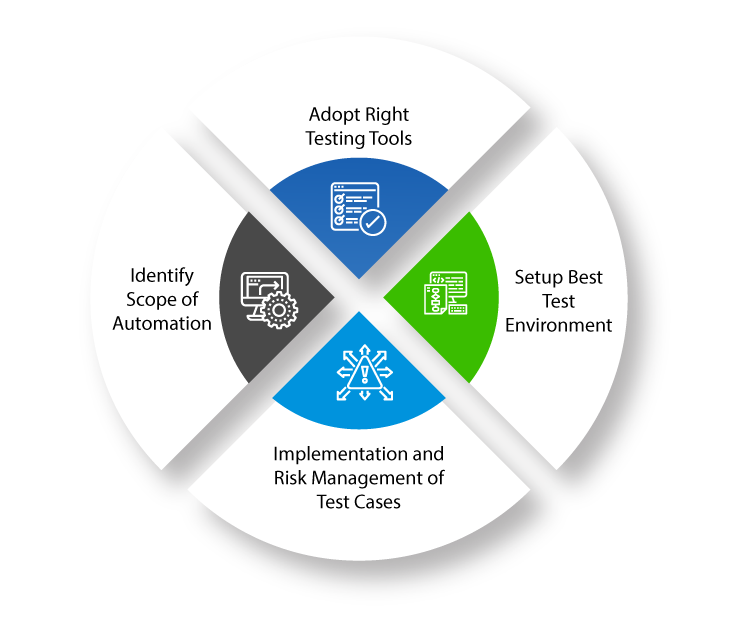



Digital innovations are disrupting the world faster than before. As businesses adopt digital ways, software engineering teams and partnering ISVs face the pressure to assure the high quality of digital applications. Therefore, software engineering teams need to adopt the best DevOps strategy, testing automation, QA practices internally to become more efficient and agile.
In the software development lifecycle, software quality assurance or testing has always been irreplaceable. It’s no different today as ISVs build teams and engage partners to independently test and certify the various applications in their product portfolio before they are made available for use by end consumers (or, indeed, by employees).
But as the landscape of enterprise applications continues to expand to accommodate the evolving needs of the target market, the ambit of software testing also grows - in size and complexity. For long, ISVs relied on test automation to enable a faster, and more efficient testing cycle.
Independent software vendors embraced test automation to mitigate challenges such as limited test coverage, possibilities of human errors creeping into test scenarios leading to missed cases, biased test prioritization, and much more. And obviously, test automation took root in the product development process.
In fact, the automation testing market size is estimated at USD 28.8 billion globally by 20241. But the process of software development, and especially product development is changing, and the world of software testing and test automation must change too.
DevOps adoption has become the accepted methodology to develop almost all modern SaaS-based enterprise products. ISVs love DevOps strategies and practices as it allows them to automate as many processes as possible in the software development cycle which will, in turn, accelerate development initiatives and help them roll out digital applications faster to consumers or end-users.
In this context, given the accelerated pace, software engineering teams should not ignore the testing phase. Therefore, test automation must become a key component of the DevOps strategy. But at that pace, if you do not lay out a perfect strategy to implement test automation for DevOps adoption, your software engineering teams risk disaster.
How Can ISVs Build and Develop DevOps Strategy with Test Automation?

Identify Scope of Test Automation
Firstly, the most crucial step that needs to be taken is to identify what must be automated. For this, all the stakeholders, including the product owners, developers, testers, and members of the design team must collaboratively identify the key deliverables, schedule delivery objectives, pin down dependencies, and define workflows.
Software engineering teams must introduce in-sprint automation to determine tasks and workflows that can be automated. DevOps is a continuously evolving method of building software. And test automation needs an iterative growth strategy too. The evolving strategy can accommodate more workflows and tasks as the software team progresses with product iterations and rollouts.
Adopt Right Test Automation Tools
Secondly, test automation and the test processes require on-boarding proven test automation tools and platforms. This enables seamless automation of workflows and scenarios. There are a few considerations factored in at this stage. These include technology stack supported by test automation tools to determine application compatibility, cost evaluation, availability of skilled resources, or enabling training the team to use the test automation tools optimally.
ISVs also need to gauge the performance of the platform and much more. The focus should be on using test automation frameworks and accelerators that speed up test performance. This can enable more efficient management of the testing initiative and empower developers to focus more on creating cleaner code. The good news is that highly functional frameworks, like our own – Xoriant iAutomate, provide great benefits already.
Whether it is your web, mobile, desktop, or API applications, Xoriant's tool-agnostic test automation framework iAutomate can remove the grunt work from your software engineering teams. Equipped with end-to-end integrations across JDBC, Slack, Jira, Sauce Labs, the framework can test a wide range of applications – UI testing, API testing, multi-browser testing, multi-environment testing, database validation.
Overall, ISVs need to invest in empowering their test practice with a test automation framework strategy. This should be robust to handle the end-to-end testing of applications on mobile and web. A good strategy should cover above mentioned multi-faceted list of test scenarios.
Setup the Best Environment for Test Automation
Thirdly, today’s enterprise products – both mobile and desktop applications are fated to encounter tons of different usage environments. Most of the deployments with DevOps are cloud-based. This involves a considerable testing team effort across selecting the right configuration, building/deploying a stable test environment on the cloud.
However, creating an autonomous test environment adds complexity. The reason being provisions for data masking, desensitization, and proactive monitoring of the test environment. The test environment is the best place to identify how various components of an application react to near real-life simulations. Getting the right test data to match real-life scenarios is important for impact analysis on application performance.
Implementation of Test Automation and Risk Management of Test Cases
With the progress on test artifacts and test environments come the implementation of automated testing in the DevOps strategy. Software engineering teams should create relevant test cases. These test cases should align with the intended objectives of the application. Feedback should be aggregated from past experiences during the implementation of test cases. This drives improvements to test cases and scenarios, including efficiency of test automation with better test coverage. Remember, this is an ongoing process and test cases get implemented and run over iterations. Continuous feedback drives ongoing remodeling for near-perfect results.
ISVs should encompass engineering methodologies that can deliver accelerated go-to-market. As ISVs scramble to build better products, they are enabling proactive test automation to improve overall product quality. Above all, it is natural for engineering teams and ISVs to embed test automation into the core of its DevOps strategy. In conclusion, the growing dynamic requests of the enterprise customers and your desire to meet these expectations with technology can converge at Xoriant.
Leverage Xoriant for DevOps Strategy, Test Automation and Support
Xoriant is a trusted technology leader and execution partner for 30+ years. We have worked with startups to Fortune 100s encompassing BFSI, High-tech, Healthcare, Pharma, Industrial Manufacturing, Telecommunications and Automotive sectors. Our expert engineering teams have abstracted successful methodologies, framework components, accelerators, to solve important client challenges with agility.
Check out our related PDF: Test Automation Framework
Learn how Xoriant is delivering innovation at DevOps speed.
Looking to reduce time-to-market and focus on continuous improvement using Xoriant DevOps strategies?
Connect with Xoriant Engineering Experts






 View Previous Blog
View Previous Blog




